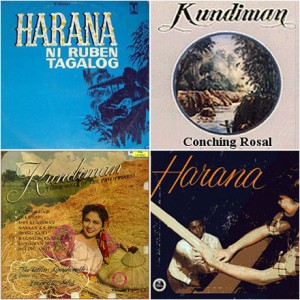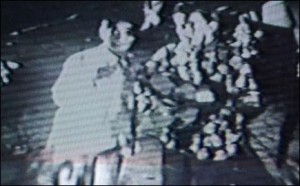If you are one of the Filipinos having a hard time distinguishing between harana and kundiman music, don’t be ashamed – you are not alone! It is very easy to confuse the two.
It is common to hear people refer to ANY old Tagalog love song as kundiman or harana. Though I cringe every time, I often don’t bother to correct them because I’m in no mood to start a dissertation type of explanation. But a blog, now there’s the perfect soapbox to indulge.
So, herewith is my attempt to correct some fallacies. To Philippine music scholars out there, feel free to chip in at the Comments section below.
Harana
During a serenade, one can pretty much sing any love song he likes, even English ones, and still get away calling it a harana. But if you are going for a truly authentic harana experience like they did in old Philippines, you have to use a particluar set of songs specifically written for the endeavor. These songs were written by some of the better-known composers in the last 75 years such as Santiago Suarez, Constancio de Guzman and Antonio Molina, to name a few.
Harana music has its very own distinctive style and a clear stamp of authenticity. In musical terms, the rhythm is habanera which is in 2/4 time. Interestingly, none of the haranistas I met knew what a habanera was. That term is used mostly in western classical music. Instead, the haranistas refer to this rhythm as danza. To hear a sample of this rhythm, click here.
The arrangement is simple and straight forward. It always starts with an introduction of solo guitar, then verse 1 followed by verse 2, then a little bit of solo guitar in the middle, then back to verse 2 until the end. Occasionally, there are short exchanges between the guitar and voice in the middle, like they do here.
Another area to look for signs of authenticity is in the lyrics. True harana songs place the singer in the act of serenading such as when he implores “Dungawin mo hirang” (Look out the window, my beloved), “Natutulog ka na ba, sinta” (Are you asleep, my love) or “O Ilaw, sa gabing madilim” (Oh light, in a night so dark).
My favorite aspect of the harana lyrics is its use of pure, unadulterated and archaic Tagalog. They use words you and I will never hear in a daily conversation in Manila. Words such as idampulay (to offer or give), tanglaw (luminous or luminosity), or pagkagupiling (a light sleep). You will also never encounter even a hint of Spanish word – a characteristic shared by kundiman songs. Harana and kundiman may be the last refuge of the ancient Tagalog language.
Instrument-wise, the guitar is the most trusted companion. Though other instruments were known to be used such as the violin and banduria most recordings of harana from the 1940s to 1960s featured only a guitar (or two) accompanying the vocals.
There are many popular Filipino love songs that don’t meet these requirements but nevertheless were used in harana. Songs such as the popular Dahil Sa Iyo by Miguel Velarde, Jr. or Dahil Sa Isang Bulaklak by Leopoldo Silos. Stylistically, the haranistas never refer to them as harana, instead they just call them ‘love songs’.
Things to look for: when you hear the danza rhythm played on guitar combined with lyrics that place the haranista in the act, using archaic Tagalog, that’s a dead giveaway that you are listening to a true harana.
Kundiman
One of the main reasons kundiman is mistaken for a harana is because haranistas would oftentimes sing kundiman songs during a harana. See how easy it is to get confused? But make no mistake, harana and kundiman are stylistically different.
Whereas harana is in 2/4/ time, kundiman is in 3/4. The formula is verse 1 on minor key (e.g. C Minor) followed by verse 2 on parallel major key (C Major) midway through. This is intractable. Stray from this formula, and you no longer have a kundiman.
As mentioned, the language is also in archaic Tagalog but the theme subject is different from harana. Kundiman songs have a fatalistic woe-is-me streak to it. He is always heartbroken, very poor with nothing to offer other than his undying love, and willing to suffer, even die, to prove his love. In fact, the word kundiman is said to be the contraction of the phrase “kung hindi man” (if not, or if not meant to be).
If there is a single art form that captures the Filipino character, kundiman would be it for it is said that the Filipino’s humble nature and willingness to be trampled on is the main reason we allowed years of colonization and oppression from Spain, America and Japan. Even a fellow Filipino dictator was in on the flogging. Perhaps a controversial statement if not an exaggeration.
Whereas harana were sung exclusively by men, the history of recordings might give you the impression that kundiman were more often sang by women. This is attested to by recordings and accounts of luminaries such as Conching Rosal, Atang dela Rama and Sylvia la Torre. This is because it happened during the advent of recording in the early 1900s as well as the rise of the formalization of kundiman art form championed by Nicanor Abelardo, Bonifacio Abdon, et al. These composers were trained in the west and were very successful in integrating the operatic aria style into the kundiman. It is sung by a soprano and accompanied by full orchestra or the piano. This is the kundiman most of us know today (samples below).
However, there was a more basic form of kundiman that existed prior to that. They were songs the commonfolk could sing, and not operatic in style. This is the kundiman that existed long before the Abelardos and the Abdons. It uses just the guitar and voice and often sung by men. These were the kundimans sung by the haranistas during a harana.
It is based on the kumintang, a true indigenous (pre-colonial) style of song and pantomime that originated in the Tagalog region, probably Batangas. The guitar was later incorporated upon the arrival of Spain. The kumintang is a whole different subject that warrants an extensive research.
Things to look for: the kundiman is in 3/4 time, starting in minor key, switching to major key in the middle, uses archaic Tagalog, with the subject matter that revolves around being heartbroken.
Chances are, you probably won’t hear true harana or kundiman in our daily lives because they are not played (or seldom played) on the radio, television, internet or live performances. And if you hear one, chances are it is kundimanin (pseudo-kundiman) and treated more like cheap ditties rather than art form.
On top of distinguishing between the two genres, I also want us to make a clear distinction between authentic harana and kundiman. There are many versions out there, including some of my own recordings, that do not exactly meet these requirements. I am not saying that other versions are not valid, in fact, I encourage evolution and modern iteration of these genres as long as they are done well and they retain the spirit. I castigate them not for being inauthentic but for being truly horrific. But that’s another topic.
So, the next time you hear an old Tagalog song, try not to automatically categorize them as harana or kundiman. Chances are they are neither because true ones are hard to come by. But should you encounter one, you may now consider yourself armed with the knowledge to distinguish between the two.
Music Samples
(Note: To avoid copyright infringement, all music samples below are truncated to about 60 seconds)
Hear an example of a true harana song:
Kay Lungkot Nitong Hatinggabi (written by Santiago Suarez and sung by Ruben Tagalog from the album ‘Harana ni Ruben Tagalog’)
Hear an example of formalized kundiman as championed by Nicanor Abelardo, et al. This example uses a string orchestra accompanying a soprano:
Nasaan Ka Irog (written by Nicanor Abelardo, sung by Sylvia la Torre from the album ‘Kundiman’)
Hear an example of kundiman in its most basic form of guitar and male voice:
Bituing Walang Ningning (composer unknown, sung by the haranista Romeo Bergunio from the upcoming documentary film Harana)

